-
Portable Speaker Power: Making the Bass Possible
Portable Speaker Power: Making the Bass Possible
Martin Moss
A lot of portable speakers are entering the market to supplement the audio performance of modern cellular electronics and memory devices that either store or play media content. The current challenge is that the physical size of portable devices is a selling factor, but batteries do not have the power density or longevity to create good-quality audio playback. Physical dimensions also contribute to a lack of deep resonant bass, making music sound distorted and unattractive.
Many manufacturers are building portable (often Bluetooth®-enabled) speakers that contain larger batteries and also have the physical size to handle low-frequency bass. There are many challenges to overcome in such designs, often relating to system integration, thermal reliability, cost-effectiveness and using single lithium-ion cell drivers for the speakers.
TI has built a reference design, showcasing how a high-performance, compact and flexible boost converter can help overcome these challenges (Figure 1).
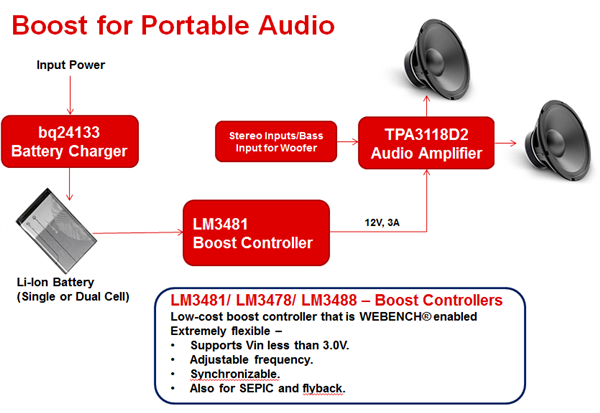 Figure 1 Portable Speaker Reference
Design
Figure 1 Portable Speaker Reference
DesignThe LM3481 boost controller supports compact designs and high efficiency. Figure 2 illustrates a demonstration of the efficiency you can expect over the load range, the comparative solution size and thermal performance.
The LM3481 offers a compact, efficient and low bill of materials solution that helps customers overcome thermal-density issues associated with the attractive small designs and shapes their design engineers use to make the portable speakers. It also supports a low-cost implementation across the full range of power output to the speakers. You can see these point within Figure 2.
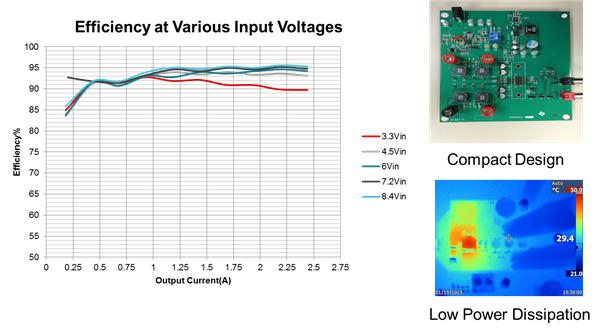 Figure 2 Efficiency, Thermal and
Solution Performance
Figure 2 Efficiency, Thermal and
Solution PerformanceThe device also supports very low Vin capability; this is particularly important for single-cell lithium-ion designs. As the power capacity of a lithium cell starts to decay, the voltage provided to the circuity will start to decay. Typically, there is a “knee point” where the battery will start to droop faster. This often translates to a condition where the speakers start to distort and the dynamic music notes will not sound as clear, as shown in Figure 3.
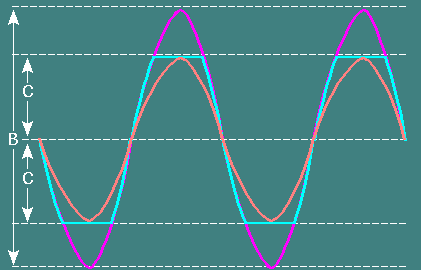 Figure 3 Audio Clipping Associated with
a Dying Single-cell Battery
Figure 3 Audio Clipping Associated with
a Dying Single-cell BatteryThe LM3481 can support the boosting of the voltage and also the dynamic load so that the portable speaker continues to perform with high clarity until the battery is finally exhausted.
As with any switching regulator, there is noise associated with the use of high-frequency transistors used in the conversion of the voltage. It is important to understand the effects of this in the final design, as well as the methods of suppression and how to avoid this noise in the audio output. Designing the integrated circuit (IC) well in the first place can minimize this (see Figure 4), also sensible and good techniques used in your printed circuit board (PCB) layout is critical in maintaining high performance. Also with lower noise from the power supply there is less interference to the Audio output, the reference design can show this as seen in Figure 5.
It is possible to offer performance that is compact, with low implementation costs and ease of design, thus giving modern portable speaker designers the ability to satisfy demanding customers.
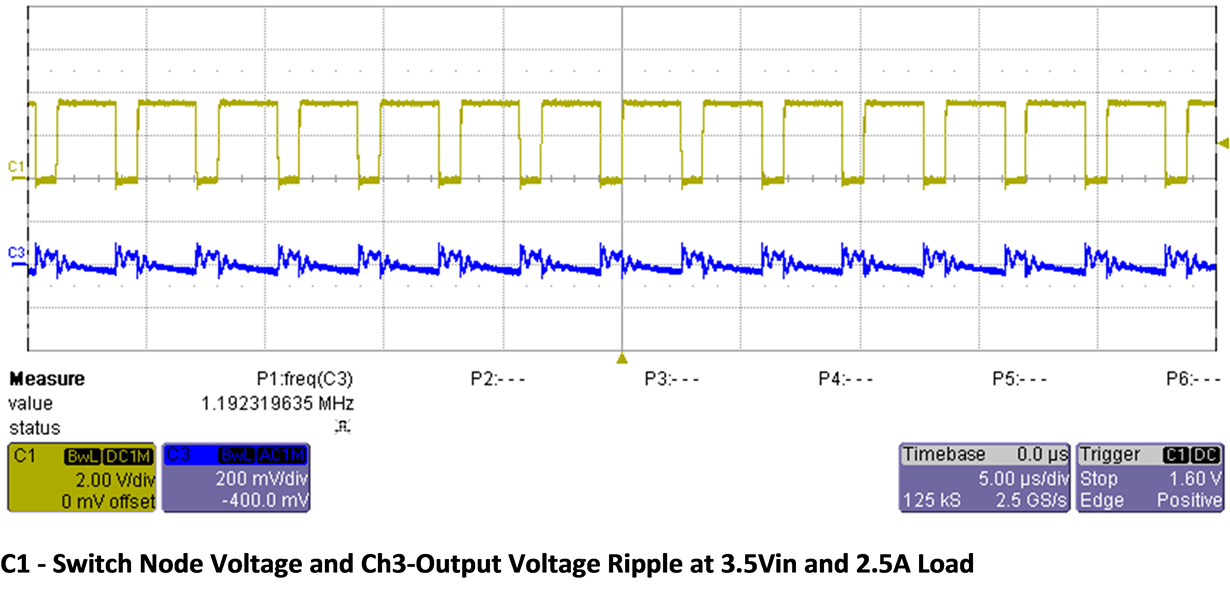 Figure 4 Output Ripple of LM3481 Demonstrating Low Noise
Figure 4 Output Ripple of LM3481 Demonstrating Low Noise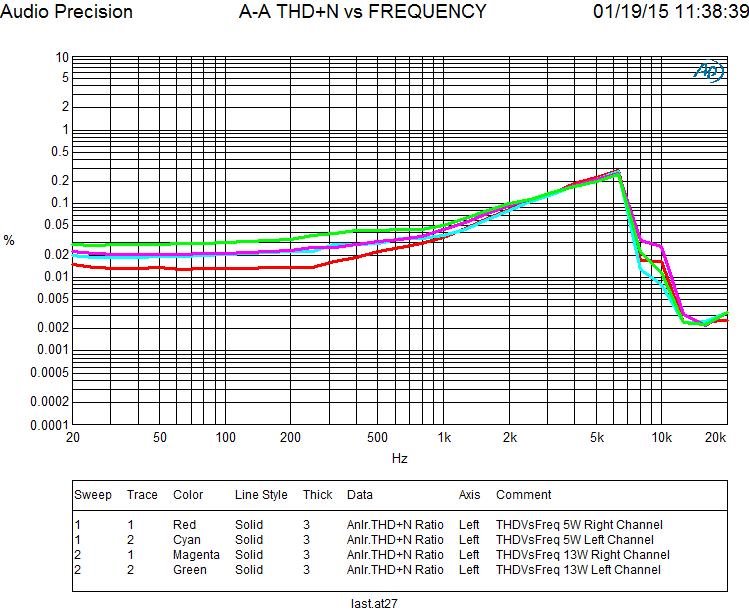 Figure 5 Solution Audio Performance
(Total Harmonic Distortion) versus Frequency
Figure 5 Solution Audio Performance
(Total Harmonic Distortion) versus FrequencyAdditional Resources:
- Watch a video "Portable Speaker Reference Design Improves Audio Efficiency and THD."
- Download the reference design "Audio Boom Box/Portable Speaker Reference Design with Efficient Boost Converter."
IMPORTANT NOTICE AND DISCLAIMER
TI PROVIDES TECHNICAL AND RELIABILITY DATA (INCLUDING DATASHEETS), DESIGN RESOURCES (INCLUDING REFERENCE DESIGNS), APPLICATION OR OTHER DESIGN ADVICE, WEB TOOLS, SAFETY INFORMATION, AND OTHER RESOURCES “AS IS” AND WITH ALL FAULTS, AND DISCLAIMS ALL WARRANTIES, EXPRESS AND IMPLIED, INCLUDING WITHOUT LIMITATION ANY IMPLIED WARRANTIES OF MERCHANTABILITY, FITNESS FOR A PARTICULAR PURPOSE OR NON-INFRINGEMENT OF THIRD PARTY INTELLECTUAL PROPERTY RIGHTS.
These resources are intended for skilled developers designing with TI products. You are solely responsible for (1) selecting the appropriate TI products for your application, (2) designing, validating and testing your application, and (3) ensuring your application meets applicable standards, and any other safety, security, or other requirements. These resources are subject to change without notice. TI grants you permission to use these resources only for development of an application that uses the TI products described in the resource. Other reproduction and display of these resources is prohibited. No license is granted to any other TI intellectual property right or to any third party intellectual property right. TI disclaims responsibility for, and you will fully indemnify TI and its representatives against, any claims, damages, costs, losses, and liabilities arising out of your use of these resources.
TI’s products are provided subject to TI’s Terms of Sale (www.ti.com/legal/termsofsale.html) or other applicable terms available either on ti.com or provided in conjunction with such TI products. TI’s provision of these resources does not expand or otherwise alter TI’s applicable warranties or warranty disclaimers for TI products.
Mailing Address: Texas Instruments, Post Office Box 655303, Dallas, Texas 75265
Copyright © 2023, Texas Instruments Incorporated